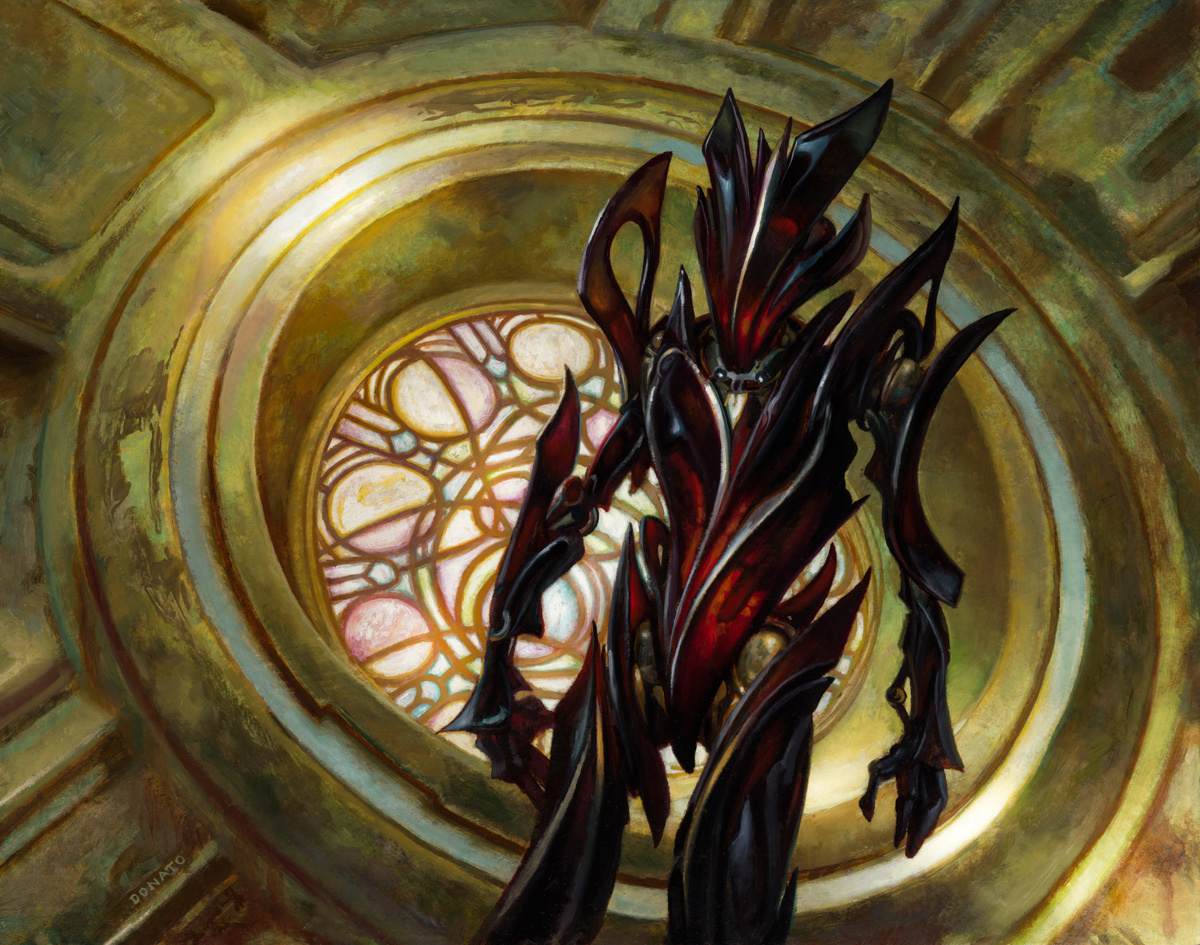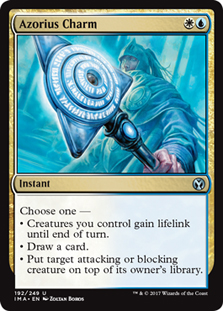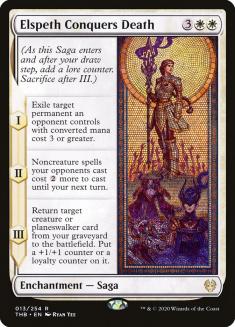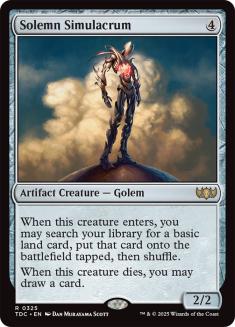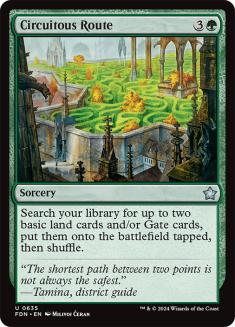Occasionally, a reprint arrives that takes this old man back to his glory days of professional play. I have had brief moments of glory over the years, either with a string of SCG Tour Invitational Top 8s or strong Pro Tour finishes. The success on the SCG Tour was thanks to Esper Control, which featured Sphinx’s Revelation and Supreme Verdict. It was tough to lose to other decks that year and I was well-versed in defeating the mirror, creating a very memorable tournament series. Unfortunately, we are not going to see cards from that era return anytime soon.
Powerful control reprints are far and few between for a good reason. When the sweepers and removal are too good, aggressive decks cannot compete. This was the story of Azorius Charm and Supreme Verdict, both of which are staples in Pioneer’s best control deck. The Devotion decks were strong competitors while legal, but the best decks were those with Sphinx’s Revelation. At a different time in that card’s legality, the best deck ran a single Elixir of Immortality as the win condition, showing off what control decks can do when powerful cards are available. As much as I would like to have more formats like those, Magic is at its best when all of the three major archetypes are competitive.
Since control’s mightiest options are not returning, I keep an eye out for cards that have crossover between different archetypes. Most patrons of the game enjoy permanents over spells and that is a fact that we all must accept. Once you have made your peace with that, tap-out control will welcome you with open arms. In this new era, planeswalkers will give the biggest bang for your buck and a nice one has returned.
Ugin, the Spirit Dragon has equally plagued and rescued me over the years. As one of the greatest Mono-Green Tron villains, it was a feared Turn 4 play in a format where removal for planeswalkers was not common. While it was in Standard, it was the savior in the late-game once my poor Dragons were slain prior to its arrival. The mana cost is prohibitive for most decks, but control can swing eight mana if it must.
Control players live for the late-game and that opens the door for cards like Ugin that typically find their way into ramp strategies. This is the crossover that I often look for — cards that may be too expensive at first glance, yet work just fine. “The more mana it takes to cast, the bigger the impact on the game” is the general rule. Control thrives by playing a very weak battlefield game early and then summoning the most powerful string of spells later. Ugin is the embodiment of that strategy.
I’m ready to sleeve up a couple of these eight-mana planeswalkers, regardless of the direction control is headed with the release of Core Set 2021. The effect that Ugin has on the battlefield is monumental, with the potential to wipe out every permanent on the opposing side.
Players like me seek this Planar Cleansing-like action because of the weak answers that control has had in each of the recent Standard formats. The counterspells have been abysmal, the removal has been mediocre, and the threats that players have had access to (especially planeswalkers) have been difficult to handle upon resolution. With the deck stacked against reactive strategies, control decks have already conceded to tapping out every turn to just stay in the game. When this occurs, a final juggernaut of a spell must land and Ugin is up for the challenge.
Creatures (7)
Planeswalkers (9)
Lands (28)
Spells (16)

Looking away from Esper or Jeskai Control, there’s an opportunity for an expedited arrival of some big-mana spells. Bant Control is on the rise, with many players choosing this over Temur Reclamation and having great success with it. I have been enjoying Esper Hero and Jeskai Control lately, but I have played a significant amount with Uro, Titan of Nature’s Wrath as well.
Uro is the quintessential crossover card, making ramp, midrange, and control decks viable. For fans of Simic-based content, the next best option outside of Temur Reclamation was obvious. Growth Spiral has been heavily played since its release and shows no signs of slowing down. I still believe it is too strong from a developmental standpoint, considering the restrictions that should be placed on a card that replaces itself.
If we find ourselves playing a deck that can incorporate that and Uro, Titan of Nature’s Wrath, we should take advantage of it. When Ikoria was first being previewed, I drafted a few possible control directions we could head in. Although a Simic-based direction was not my first choice, I noted that the cards in that color scheme were easily the most powerful. The traditional control player in me wants to play the colors with the best removal, but it’s time to accept that the most powerful cards are needed to tackle a format plagued by balance issues. These Simic cards will allow us to summon Ugin sooner while drawing cards and gaining life in the process.
The draw to white has been Elspeth Conquers Death for months and it is the enchantment I cannot live without in Standard. That, combined with the strength of Shatter the Sky, has made white the go-to color to make Bant Control strong enough to contend with the other strong decks in the format. White also brings a couple of two-mana enchantments that are strong, especially when using Yorion, Sky Nomad to blink them later in the game. I am not convinced that Yorion best fits this style of control deck, so I opted out of using it to start the new format.
The current Bant Control lists that you see, with the addition of Ugin, will be competitive all the way through rotation. Although we are losing Teferi, Time Raveler and a few of the busted Simic cards after rotation, many of the control elements will survive. We are still a few months and another whole set away from that brand-new Standard, but I like to consider these when picking up control staples. The strong Azorius Control deck we played for months, combined with the broken Simic options around us, makes a Bant Control deck that has the best of all worlds. Growth Spiral allows us to hit land drops and play our spells ahead of schedule, but a new arrival has made that mission even easier.
Solemn Simulacrum may be the most exciting reprint I have seen in many years. I am not fooled by the nostalgia that Solemn Simulacrum brings, and I am fully aware that it will not define formats like it once did. My greatest memories come from the sad robot, as it was a vital piece of my Azorius Tron deck at Worlds in 2006. Undefeated on the day, I mistakenly drew into ninth place, but the five easy wins were thanks in part to this colorless four-drop.
That was in the Extended format, one that had powerful spells flying around and there was still room for Solemn to shine. Not only was it great here, it was a staple of my Selesnya Control Top 8 at Regionals in 2003. So many good memories surround Solemn Simulacrum, but the objective deckbuilder in me pushes that aside. It’s business as usual as a new set is about to be released and this reprint is going to significantly further control’s chances of winning matches.
Although Solemn Simulacrum is not where it once was in power level, it has not lost a beat as a role-filler. In Bant Control, it ramps, blocks, and draws a card on Turn 4 on average. At best, Solemn Simulacrum arrives on Turn 3 after a Growth Spiral, giving control mages six mana to work with two turns early. This start for Bant Control is tough to take down, even for some of the fastest decks in the format.
The late-game cards, which now can come down more consistently on Turn 4, can wreak havoc while the opponent sits there with three lands on the battlefield. This type of mana advantage is at the core of unbalanced games, which ramp players attempt to take full advantage of. The difference between ramp and control players in this context is that our spells that advance land drops also keep our hands full.
Control players always have access to mana ramping cards, but we chose to ignore them for a good reason. Filling your control deck with a bunch of spells that just put lands onto the battlefield can often lead to flooding, poor late-game draws, and a requirement to only play big payoff spells. Having cheap, interactive spells with a ton of ramp has rarely been a winning strategy.
Control wins by being lean at the start of the game and ending with a few expensive spells. Ramp decks play a ton of late-game and ramp spells, with the hope of drawing more acceleration than bombs early on. Control does not have that luxury and is required to interact early, while turning the corner with something big right after. Therefore, Growth Spiral and Solemn Simulacrum are unique and easily fit in a control shell. The card advantage brought by Solemn Simulacrum is what makes it a control staple, but a fringe option for true ramp decks.
Ramp decks would rather play a Circuitous Route than Solemn Simulacrum any day. Their goal is to get a handful of giant monsters onto the battlefield, in creature or planeswalker form, as early as possible. Solemn Simulacrum does not provide that service effectively at four mana, making it lackluster for those players. Our robot friend is sad on social media these days, watching high-profile players dunk on its capability in Standard. Polls like this one have some of the strongest players in the world describing its inevitable flop.
Analyzing Solemn Simulacrum in the context of the past is already a slippery slope, but the lens in which they do so is incorrect. It will not be a ramp card, but a control role filler as discussed. We are in the business of getting land, blocking, and drawing some cards, all of which Solemn Simulacrum does for a reasonable mana cost.
LSV jokingly replied to Zvi about what four mana should deliver and, in a vacuum, he is correct. Countering a spell for three mana, casting a six-mana creature with no enters-the-battlefield ability, and making a Wall of Omens that gets a Plains instead of drawing a card are all mediocre at face value.
Control cards should be judged and analyzed differently from those that seek to get placed in every on-color deck in the metagame. For my readers out there, I have already found a home for all these cards in this decklist above. I’m excited to try this on release day coming up and I’m confident that it will deliver. More specifically, Solemn Simulacrum and Ugin will exceed the low expectations that many have for them.
With these new additions, and all the permanents that have enters-the-battlefield effects, it hurts me not to use a synergistic companion. Yorion, Sky Nomad is still very powerful; however, it may not be the best in this broken format we find ourselves in. Wilderness Reclamation is one of the most unforgiving Turn 4 plays that we can find ourselves facing when we are tapping mana down to bring Yorion, Sky Nomad to our hand and when we cast it in one of the following turns. I’m confident that we will move to 80 cards once the last combo piece dies off in Standard, but until then, we are back to a 60-card norm.
Enjoy the new deck in this troubled format and I look forward to your feedback!

